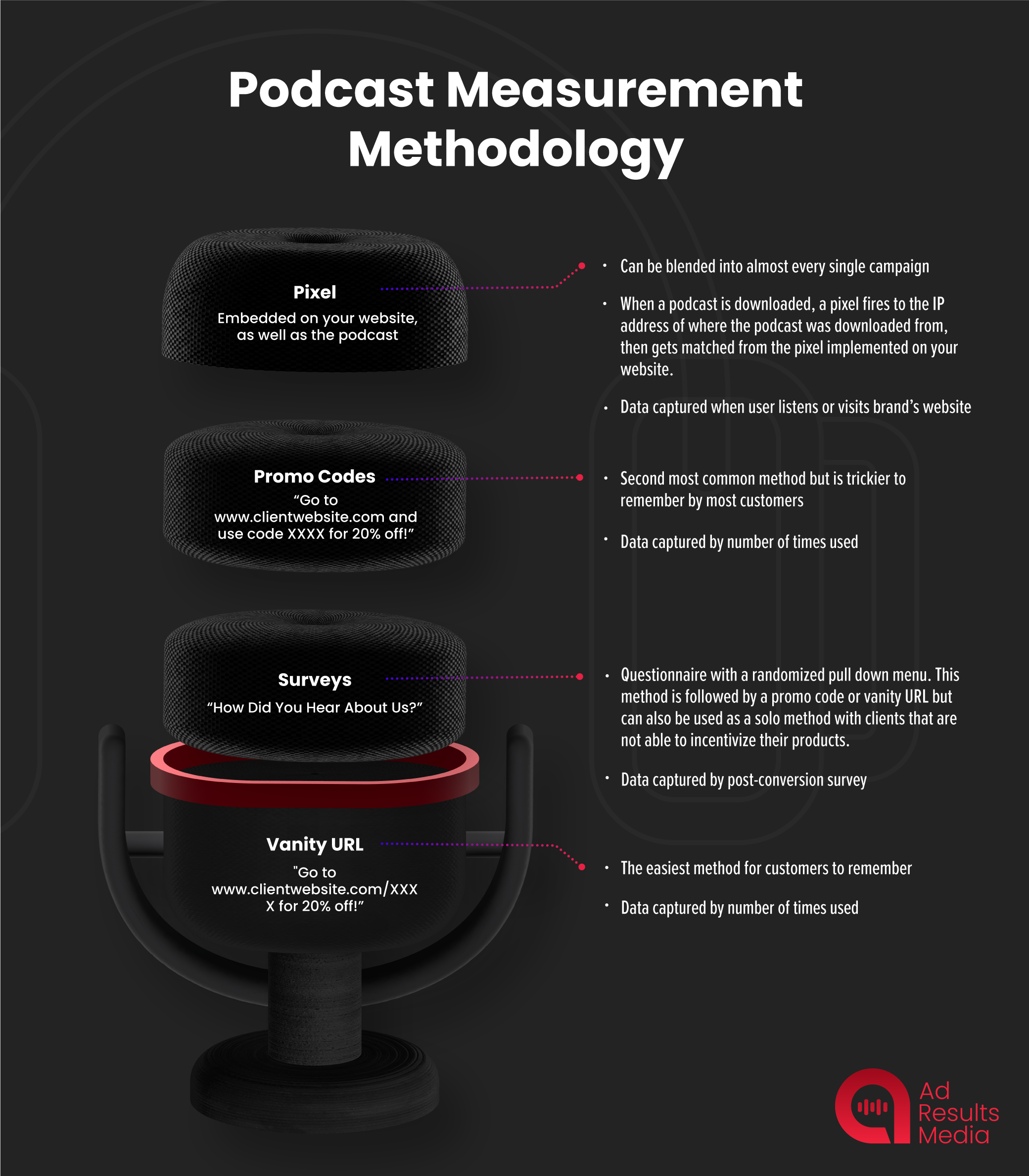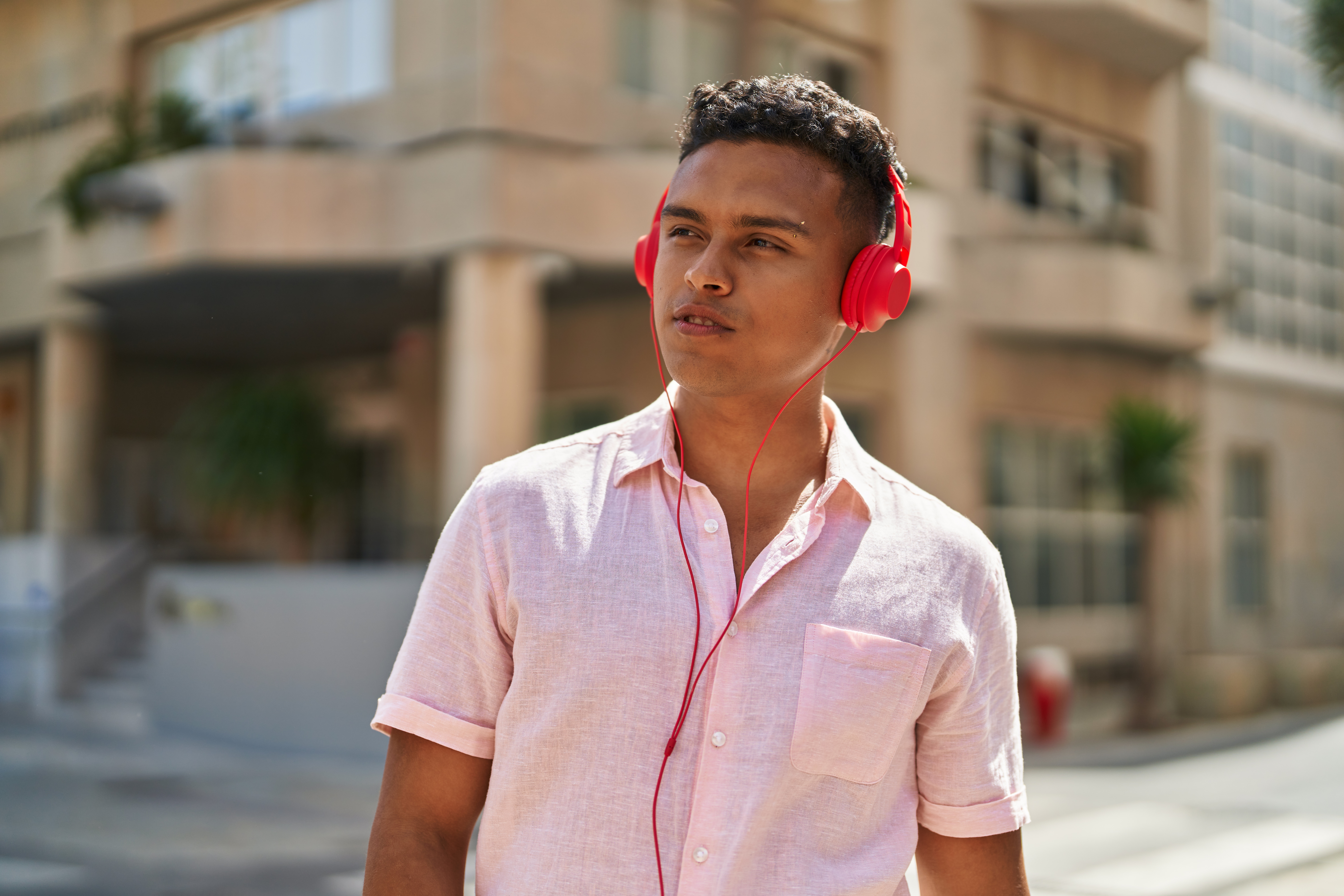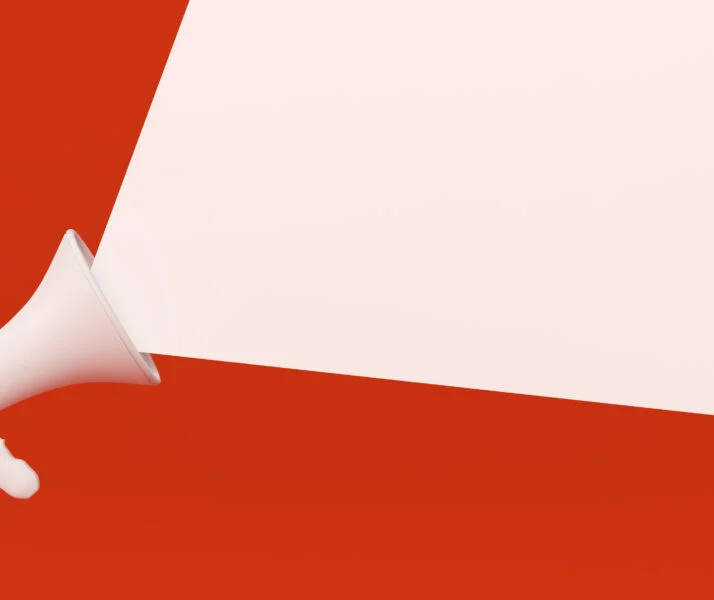
Introduction
Podcast advertising is an expansive and powerful medium that continues to grow in popularity across the market. There are numerous benefits, strategies, and types of podcast ads that can be deployed to meet various goals throughout the entire marketing funnel. In this article we’ll describe how to advertise on podcasts, share some examples of podcast ads, as well as discuss strategy and measurement. Read on to find out how this medium can work harmoniously with the other channels in your media mix to increase brand awareness, promote conversions, and support overall growth.
Types of Podcast Advertising
There are several different types of podcast ads, differentiated by things like when the advertisement is played during the show, who delivers the ad, as well as different styles that include sponsorships and custom segments.
Additional options included live-read or pre-recorded, voiced over ad reads (which means the ads are recorded by someone other than the show host), as well as branded series and custom segments. Some brands have also found success with producing their own show content.
For most ad types, brands also need to consider when they want each ad delivered within the podcast episode, which typically means deciding on a pre-roll, mid-roll, or post-roll spot, and how they want the ad to be communicated (live endorsement, pre-recorded ad with CTA).
Benefits of Podcast Advertising
The benefits of podcast advertising are many. Podcasts have gained a reputation for being incredibly effective because of their ability to reach niche interests and communities, deliver high levels of audience segmentation, and for the trust and memorability they create.
Some of the biggest benefits of podcast advertising include:
- Podcast audiences are engaged. When people tune into podcasts, they are captive and engaged. Listening devices like smartphones account for the most listening hours, wherein most listeners tune in with headphones. And 64% of those listeners say they aren’t just giving their full attention to the podcast content, but also to ads on their favorite shows.
- Podcast listeners trust the medium. As a result of the intimate listening environment of podcasting, hosts develop a unique relationship and a high level of trust with their listeners. 75% of listeners say they trust the hosts they tune in to regularly—meaning endorsements can prove powerful for brands.
- Podcasts are highly targeted. Podcast advertising can target podcast categories, specific demographics, and niche audience segments to ensure advertisers reach the right audience at the right moments. These kinds of targeted, personalized ad experiences resonate with listeners on a deep level and maximize ROI. Targeting can be executed by working with the network or shows directly to build a plan that meets the brand’s target audience needs, or by building a targeted plan through programmatic means.
Is Podcast Advertising Effective?
Are podcast ads actually effective? Before making an investment, it’s important to understand how podcast ads work, define unique business goals for a podcast campaign, and review the kind of ROI podcast advertising typically delivers. This will ensure their efficacy for your brand.
In addition to the benefits and data shared in the previous section, an impressive 71% of survey respondents in Sounds Profitable’s latest study, The Ad Bargain, stated they are more willing to consider products or services after they learn about them via podcasts. This is higher than TikTok, YouTube, Instagram, and all other forms of media. Additionally, 53% of podcast listeners said they would be likely to purchase a brand they heard advertised on a podcast. Given the statistics around podcast advertising, it is safe to say that the medium delivers results.
Related Content:
- Podcasts: More Than Meets the Ear [Free Ebook]
- The Four Super Powers of Podcast Advertising [Free Whitepaper]
- Is Podcast Advertising Effective?
How Much Does Podcast Advertising Cost?
Podcast advertising rates can vary widely depending on the podcast, the platform, and the type of ad spot.
The basic formula when determining how much one spot ad will cost is based on the CPM rate the media is being sold for (cost per 1,000 downloads) multiplied by the size of the show’s audience (how many downloads per episode).
CPM x # of episode downloads = ad spot cost
Other variables such as whether the ad is a pre-roll, mid-roll, post-roll, a live-endorsement or pre-recorded ad voiced over by someone other than the show host, whether the ad is baked into the show permanently or dynamically inserted with a limited run time and the length of the ad (:15, :30, :60, or longer) are also factors.
For more specific pricing information, please contact the Ad Results Media team for a free consultation
Podcast Advertising Examples
When you look for which brands are the top spenders in podcast advertising, names like BetterHelp, ZipRecuiter, Stamps.com, LiquidIV, Gametime, Policygenius, and Molson Coors often pop to the top of the lists. All of these brands have two things in common, they are looking for new avenues to reach highly desirable and engaged audiences, and they are looking to do it in an effective manner with attention to performance, which is measured by both direct sales and brand lift. It truly is one of media’s best open secrets and it’s why it has been one of the fastest growing advertising mediums over the last few years.
We believe that podcast advertising is the ultimate driver of brand marketing success. Our clients have been able to demonstrate impressive and meaningful results.
[Read More: Podcast Advertising Examples]
How to Advertise on Podcasts
Advertising on podcasts is easier than you might think. Yet, like launching any campaign, it requires following a protocol to ensure that strategy is focused, KPIs are defined, and methods are tailored to the results you’re after.
Create a Podcast Advertising Strategy
Creating an effective podcast advertising strategy requires work up front. This includes having a clear understanding of your budget and KPIs, having a clear understanding of your target audience, aligning with the right creators while considering cost, historical performance and related brand safety and suitability elements. Additionally, teams must determine the right podcast ad delivery method to meet your unique goals.
Understand Your Audience
It is critical to a successful campaign that brands have identified their target audience and have considered the types of messaging that are relevant and resonate with them. This background can help them and agency partners identify creators that are well-aligned with the audience, and craft CTAs that will drive action.
It can be helpful to identify the top 2-3 affinities that index high with your audience and then do a search for podcasts that focus on the lifestyles and passion points of your customers. Next, we recommend you vet those shows using their historical performance data and their propensity to drive your KPIs.
Find the Right Podcasts
There are a lot of podcasts to choose from. When a brand sets out to find shows that will resonate with their target audiences, the prospects may seem endless. In the same way finding the perfect influencer partners on social media can seem overwhelming and manual, now imagine doing that without the functionality of the social media platforms and the additional benefit of hashtags.
Once you make a list of potential podcast hosts and/or show partners, you need to begin vetting them for campaign fit by downloading and listening to two or three of their episodes. This will help you get a feel for the content and tonality of their show and what type of ad creative may resonate best. This is also far more arduous than simply scrolling through an influencer’s Instagram feed to get a sense of brand fit and content style.
When you partner with a specialty agency that has successfully run tens of thousands of campaigns, they have proprietary tools that assist with the selection process as well as historical knowledge and relationships with the top-performing shows by genre to reduce vetting time. For example, at Ad Results Media we leverage our granular level of expertise, built over 10 years in podcasting specifically, 1000’s of touch points, 6,000 individual podcasts tested and performance data collected.
Understand Direct vs. Programmatic Podcast Buying
Podcast ads are bought either directly through networks or programmatically. through the use of DSPs (demand-side platforms). As part of your podcast advertising strategy, you’ll need to choose which of these ad types your strategy will include.
With direct buys via networks, brands have the ability to leverage live host-read ads as well as ads that are pre-recorded and then dynamically inserted into the content. Alternatively, programmatic ads solely offer pre-recorded advertisements that are dynamically inserted into the content.
When buying direct, brands work with agencies, networks, or creators to negotiate rates and secure inventory. On the other hand, programmatic buys are secured through a demand side platform (DSP) like AdsWizz or Audiohook. Each method has its benefits. When buying direct via a sales rep at a network, rates are negotiated to more competitive levels, media can be purchased upfront, and often brands can secure larger integrated show and host partnerships on podcast platforms, as well as YouTube, the host’s social media channels, and even live events. Direct buys include live, host-read ads, pre-recorded host read ads, and those voiced over by a third party.
Benefits of programmatic include seamless access to hyper-targeted audience segments across a majority of inventory owned by all networks based on demographic, behavior, geography, device type, time of day, and more. Programmatic can facilitate the purchase of ad space on shows aligned with brand values, meeting safety and suitability requirements while offering contextual targeting at lower rates. However, there is no guarantee that ads will run and ad options are limited to pre-produced ads that are dynamically inserted into the show pre-roll, mid-roll, or post-roll.
Ad Results Media believes they are both programmatic and direct placements are critical components within any brand’s overall media mix. They work to augment one another’s inherent strengths and deliver even greater results when run in tandem.
Related Content:
Choose the Right Types of Ad Placements
Choosing the right type of ad placement—in regards to where in an episode an ad runs and how it will be delivered—is an important piece of strategy. When considering these options, budget, creative, and length are considerations that can guide you to the right choice.
What are the Types of Podcast Ads?
- Pre-Roll: Ads that are usually 15-30 seconds long and run before or after the show’s intro.
- Mid-Roll: Ads that are 30-60 seconds and are inserted around the midpoint of an episode.
- Post-Roll: Ads that are 15-30 seconds and run at the end of the show.
How are Podcast Ads Placed on Shows?
- Live ad reads: These are performed by the show’s host and are executed pre, mid or post-roll.
- Dynamic ad insertion (DAI): leverages pre-produced ads (host or non-host read) and uses server-side ad technology to insert audio ads into live linear programming on-demand based on a myriad of factors including geo and audience-based targets.
What are the Types of Podcast Ad Reads?
- Host Read: Live Read or ads that are pre-recorded by the host
- Non-Host Read: Ads that are read by someone other than the host and pre-recorded. Also called, “voiced-over” ads.
Develop Podcast Advertising Creative
We recommend starting your advertising test-and-learn strategy with host live-read ads as they tend to perform best.
The power of persuasive podcast advertising is super-charged by the authentic and credible endorsement of the host and the fact that it is an opt-in medium where listers are choosing to spend their time with the host vs. an ad being pushed out to them digitally. Therefore, it’s important to give the host some creative freedom to deliver your brand’s messages in a manner that they believe will best resonate with their listeners as the trust and credibility with listeners has already been built.
Develop a comprehensive and adaptable messaging brief that includes your recommended messaging hierarchy, content do’s and don’ts, as well as mandatories with a list of the desired actions you would like the listeners to take after hearing your ads. This is the type of information the host needs to craft effective integrated ads delivered in their unique voice with relevance to their audience.
Related Content:
- Podcast Ad Copy Writing 101 – Episode 1
- Podcast Ad Copy Writing 101 – Episode 2
- Podcast Ad Copy Writing 101 – Episode 3
- Spoiler Alert: Better Creative Lowers Your Podcast Advertising CPA
- Podcast Advertising Types & Examples
How to Measure Podcast Advertising
There are many effective ways to measure success for your brand and calculate ROI when it comes to your ads on podcasts. As with any media channel it comes with some measurement and attribution challenges, though technology for podcast ad measurement has rapidly caught up to demand thanks to growth in this category. There are a number of methods that can be used as standalone solutions or in conjunction with other methods to paint a very accurate picture.
Although a number of these methods offer more granular attribution when a brand controls its own point of sale, effective measurement is not limited to direct-to-consumer marketers only. With recent advancements and new capabilities offered by 3rd party providers, virtually any business model can structure an effective test and learn campaign to begin to establish a baseline ROI for podcast advertising.
The following measurement methods work across all common types of podcast advertising formats:
Direct Response Methods
At ARM, we believe precise measurement is at the heart of any successful campaign, guiding it to greater efficacy during a series of tests and adjustments. Direct response methods are one strategy for measurement that encourages listeners to take a specific action, usually with an immediate goal of driving sales conversions.
Promocodes
In order to drive trial, incentivize purchase or enable mass sampling efforts, brands can offer a custom promocode on each podcast they are advertising on. A podcast host will include mentions of the promocode in the main content of the episode or they can be promoted using more traditional ads and companion units. Creating a unique promocode for each podcast or podcast episode is a great way to capture granular show-level data to establish who is more efficiently driving sales. In order for this to be effective, it is critical to make sure your technical infrastructure supports the capability to create and track multiple unique promocodes and your sales channels (direct or through a 3rd party) can accept promocodes and provide reporting data on usage.
Vanity URLs
Brands who are trying to drive immediate conversations or generate more broad-based consideration and engagement, can measure their success using vanity tracking URLs. This tried and true direct response measurement tactic is just as relevant today for podcasting as it has historically been for DRTV. One way to create a more seamless transition and “warm handoff” when using vanity tracking URLs is to create custom landing pages that mention the referring content, offer or podcast. These will reaffirm to the consumer that they are in the right place as well as generate a little good will by reminding them that your brand is supporting their favorite podcasts with your advertising.
Similar to making sure your technical infrastructure supports unique promocodes, the same rules apply to vanity tracking URLs. You need to be able to generate and track these URLs with ease and granularity.
Surveys
“How did you hear about us?” surveys are an excellent way to augment automated tracking data with self-reported responses from consumers. When a consumer looks to make a purchase directly from a brand or through one of their various other sales channels, asking them where they heard about the brand is a great way to attribute exposure and, more importantly, recall and channel effectiveness. Listening to a podcast demands your full attention and an advertiser’s message is often more salient and memorable than on other channels. Asking a consumer which channel they attribute for their visit or purchase can prove out the importance or persuasiveness of podcast advertising.
Direct Response + Attribution Based Methodologies
Direct response and attribution-based podcast ad measurement take into account all the unique touchpoints that guide people to conversion. Providing a nuanced look at the customer journey, these work seamlessly together to tell advertisers how much credit each ad interaction gets for conversions.
Pixels
The newest addition to the podcast measurement ecosystem is using pixels to track exposure and subsequent website activity. One of the fundamental challenges with this method is that podcast listening often occurs “offline”, after the podcast episode has been downloaded. Therefore podcast downloads are considered impressions – whether the user has listened to the episode or been exposed to our ads. While this can be very frustrating, there are several 3rd party measurement partners that are generating technical solutions to pixeling the RSS feed that is used to download the podcast file and then tracking the user’s resulting visits to your site. While this is by no means perfect, the important benefit is that it actualizes the ability to measure many more success metrics including: Impressions, CPM, Average Order Value (AOV), Cost per Acquisition (CPA), Total Sales and Total Site Visits.
Brand Lift Studies
For brands that do not offer consumers a direct conversion opportunity or simply want greater insight into how effectively they are communicating with new or existing audiences, Brand Lift studies offer a great measurement solution. Brand Lift studies are designed to measure a variety of outcomes, ranging from brand perception to purchase intent, using online surveys. These surveys most often use either a “pre/post” or “controlled exposure” methodology.
A pre/post survey is designed to measure the impact that the ad exposure had on achieving the desired outcomes by surveying both the exposed and control groups and calculating the incremental lift of the exposed group. With pre/post surveys the primary criteria for recruitment is whether or not you have been exposed to the ad. These surveys are excellent tools for measuring ROI or ROAS.
A controlled exposure study is generally used to measure specific aspects of ad effectiveness against a defined audience who has been conclusively exposed to the ad content. When a consumer is served a controlled exposure survey, they are asked a series of pre-qualifying questions to ensure they fall within the correct audience segment(s). Then they are asked to respond to a survey on their impressions of the ad – including message, relevance, creativity, resonance, etc. These surveys are great tools for refining your ad strategy for your target audiences.
As marketers, we all strive to achieve full funnel measurement that helps us understand the impact our advertising has on the full consumer journey. At Ad Results Media, our measurement specialists work with our clients to develop measurement plans that utilize one or more of these measurement methods to get a more full funnel picture. Please contact us today to request a consultation.

Related Content:
- [Podcast] Podcast Measurement & Attribution
- How To Measure Podcast Results
- Is Podcast Advertising Effective?
Choose a Trusted Podcast Advertising Agency
As the podcast advertising space begins to mature and welcomes more and more advertisers, the solutions will begin to become more turnkey – but until that time, specialty agencies bring the expertise, tools and solutions to navigate this space successfully.
Ad Results Media has the unique ability to centralize a fragmented industry into one touch point. We offer multi-platform audience access across many different content and network vendors versus dealing with multiple points of contact, including:
- A media planning and strategy team specializing in podcast plan development resulting in a single point of contact to buy across thousands of shows
- A dedicated analyst team specializing in audio measurement, performance analysis, and optimization
- A Media Ops department dedicated to ad air checks, ad grading, ad compliance, and brand safety and suitability
- A dedicated Creative team for all ads development, production, and ads trafficking
Conclusion
Weekly audio listening has hit an all-time high, with 98M Americans tuning in every month. Along with this increased reach, they are also clocking lots of listening time. In fact, the average American listens to a total of 8.3 podcast episodes weekly—that’s a significant chunk of time and attention.
At Ad Results Media, we’ve spent a decade specializing in audio, being witness to the medium’s tremendous growth and helping our partners capitalize on it. We’ve grown alongside podcasting, incorporating measurement methods that quantify success while refining methodologies to deliver the most cutting-edge capabilities to meet every campaign objective. We work closely with clients to create custom plans that drive success and have a ripple effect throughout the organization.
It’s our privilege to work in a medium that is dynamic and ever-evolving, helping our partners adapt, adjust, meet demands, and accomplish their goals.


